You might’ve heard of ‘box breathing technique’ or maybe the term ‘1 to 1 breathing’ or ‘square breathing’ is more familiar to you.
For those, that might not know what it is – what is box breathing?
Here is a simple explanation of what it is, how it works, and three different visual guides for you to follow along with!
Be sure to check our free Circular Breathing Gif and training at the bottom of the page – a more flowing and rhymic version of the Box Breathing Gif
As well as testimonials from all kinds of people explaining how they use it within their professional lives! A navy Seal, a singer, and an athlete all share their stories below…
But let’s first learn more about what the technique entails.
Box breathing is a certain type of diaphragmatic breathing (abdominal breathing) technique that is a powerful tool used for slowing down the breath, calming the bodily system down (nervous system, heart rate, and breathing rate), relieving muscle tension, and reaching a state of heightened concentration, awareness, and deeper focus. It is therefore a great way to decrease stress if practiced often.
Various types of people practice this breathing technique and other similar deep breathing exercises for these reasons! Not just meditation gurus or Yogis! The technique is used across the board from athletes to nurses to the Navy SEALs.
Four-Square breathing is especially useful for those that struggle with lung disease/pulmonary disease or function of the lungs as it can help by increasing lung capacity and efficiency of the absorption of oxygen into the body.
The matching of the inhale and exhale with a hold in between creates a meditative flow of breath control – which can alter the way we breathe in general if practiced often. This is known as mindful breathing.
Carry on reading to learn exactly how this works
How Does Box Breathing Work exactly
When we are stressed out or anxious, our body produces adrenaline which causes us to breathe faster than normal meaning our carbon dioxide rises while our oxygen levels drop – our breathing pattern changes. This can lead to shallow breaths that don’t allow enough oxygen in the lungs. When this happens over time, it leads to chronic anxiety and other health problems such as high blood pressure, heart disease, diabetes, depression, insomnia, headaches, etc.
Box breathing allows us to lengthen our breathing rate out which helps us to breathe deeply. Deep breathing channels our rest and digest, nervous system and therefore reduces feelings of anxiety. Ever wondered why someone suffering from a panic attack is told to count their breaths? This is exactly why counting your breath allows you to focus on shifting shallow breathing to deep breathing.
So then let’s look at this in a more practical way – how can it specifically be used to move through feelings of anxiety and nerves…
Square breathing for anxiety and nerves:
Box breathing has time and time again proved to be very useful as a means to calm somebody down that might be suffering an anxiety attack, simply by taking long, deep breaths.
It is therefore a powerful tool to use as a self-regulation practice or skill. It can effectively get somebody out of a hyperventilating state as it calls for breathing deeply and slows the rapid ‘chest breathing’ down.
It also gives the mind one singular thing to focus on which distracts the mind from the trigger that might have brought the panic or anxiety attack on.
There are many other benefits of this type of breathing that extend far past dealing with anxiety.
8 Benefits of the Circular and Box Breathing Exercise
Box breathing/Circular breathing can be useful in many situations such as:
1. It can help you cope with panic and stress when feeling overwhelmed. Counting helps to take the focus from the panic-producing situation enabling you to handle and control your response.
2. Helps to prevent insomnia and drop into a restful sleep
3. The rhythmic breath instruction helps control hyperventilation or panic attacks
4. Build focus and awareness around breathing which is a way of practicing mindfulness
5. Helps to feel less panicked, worried, or stressed
6. Increases general sense of calm
7. Can help when needing to make a big decision as it turns the focus and awareness inwards which taps into our sense of intuition. Ultimately creating time and space to make a calm and rational decision.
8. Lowers blood pressure
9. Improves mood by decreasing cortisol which is our stress hormone
So now you might be asking yourself… “Is there a specific time or place I have to practice for the benefits to take action?”
Where to Practice Box Breathing
You don’t need any special equipment to start practicing box breathing. You just need to have an open space where you won’t disturb others. The best place to practice is at home so that you can easily repeat the process whenever needed.
Find a comfortable position and try to ground your feet flat on the floor – this adds another element of focus and attention to the body as it tells our mind we are supported and stable in a physical sense which ultimately relates to a mental state.
Although it is very beneficial for when we are feeling stressed or panicky this technique can be done whenever and wherever – it does not matter which state you are in…
When we practice box breathing when we are in a calm state we teach the brain to access this type of breathing when we are feeling stressed or anxious as it associates this type of breathing with a sense of calm. This can then become an automatic response to high levels of stress or anxiety or panic. Not only can we then help ourselves when we feel these feelings but we can effectively help somebody else when they might need it.
This along with many other relaxation techniques, such as progressive muscle relaxation can have a huge positive impact on our stress levels within daily life.
Interestingly enough box breathing was issued by many different people across many different perspectives. NAVY SEALS, singers, actors, athletes are just some examples of people that implement this type of breathing to guide them into performing better.
Where does it come from – Why do NAVY SEALS do box breathing?
Box breathing is used as part of the NAVY SEALS training regime to control their breath and stress during combat. Breathing techniques such as this one specifically also help with hand stabilizing in the case of precision or sniper shooting.
I first learned to control my breathing while practicing martial arts during my SEAL training, and the techniques I was taught proved invaluable later during the chaos of combat.
My favorite breathing practice, which I developed to continue my breath training after the SEALs, is something I call “box breathing” because there are four parts of the practice. It is something you can do anywhere and any time, so long as you are not performing a highly complex task. I practice it in the morning, before a workout, while standing in line, while I’m stuck in traffic, and whenever else I can. It helps me slow down my breathing rate and deepen my concentration. When I perform box breathing, even just for five minutes, I am left with a deeply calm body and an alert, focused state of mind. (time.com)
Mark Divine, U.S. Navy SEAL and founder of SEALFIT.
Breathing drills matter to me because I grew up with asthma. As an active athlete my whole life, I faced additional challenges in my health and performance. I did not know of these drills growing up and firmly believe incorporating them on a regular basis would have changed my athletic career. The best education at the time was to go to a doctor, use an inhaler, and stop playing when it got too hard.
This message has all been too prevalent for athletes with breathing issues. Doctors and medications are still important, but there is so much more we, as coaches, can provide our athletes. Beyond this, there are common issues most athletes suffer from when it comes to breathing.
Tom Broback, life-long athelte and physical therapist coach
Breathing Drills for Athletes
So no it isn’t just a woo-woo method practiced only by monks or yogis. A common misconception.
How square breathing technique is practically used by many:
- Used by performers before stepping on stage as a form of calming nerves and gaining focus
- Used by actors as part of a vocal warm-up to practice breath control which improves voice projection, resonance and reduces straining the vocal cords
- For precision shooting to stabilize the hands and increase alertness
- Calming nerves and improving focus during a test
- Energizing when feeling tired
- Disengage a panic attack
- When caught in an argument and instead of impulsively reacting calming the nervous system down to think about what to say
Breathing is an essential part of singing because it provides both the quality of sound and the volume level. Without the proper amount of air passing through the vocal folds, a sound is not possible. That is why breathing exercises are critical to the success of any aspiring vocalist.
Improving breathing techniques allows a singer to have more control over their voice. Greater mastery will enable them to explore a broader range of notes and to hit those tones and semi-tones accurately.Knowledge of vocal breathing exercises will also allow sustained singing stamina, and the ability to execute advanced techniques like vibratos and tremolos.
Essentially, if you want to become a better singer, you need to explore breathing exercises.
https://www.musicgrotto.com/breathing-exercises-for-singers/
Another thing to know, this is a great breathing technique to teach and practice with children, and if it can have such a positive influence on our minds imagine what it can do for our younger generation with their highly absorbable minds.
Square Breathing for Kids
Box breathing is also a great way to introduce breathing techniques to kids! The idea of the square creates an imaginative visual cue for the breath. Which benefits the child’s developing mind greatly too.
Using shapes to teach breathing methods to children is proven to be very effective as it still adds the element of playfulness while activating their learning centers.
- Star Breathing
- Triangle breathing
- Lazy 8 breathing
- Box or square breathing
Are all techniques that can help in teaching your child how breath control works and help when they are feeling scared, anxious, overwhelmed, or fearful. These basic emotions, that children regularly experience, can relate to how they would cope or handle more complex situations and emotions, later on, in their adult life too.
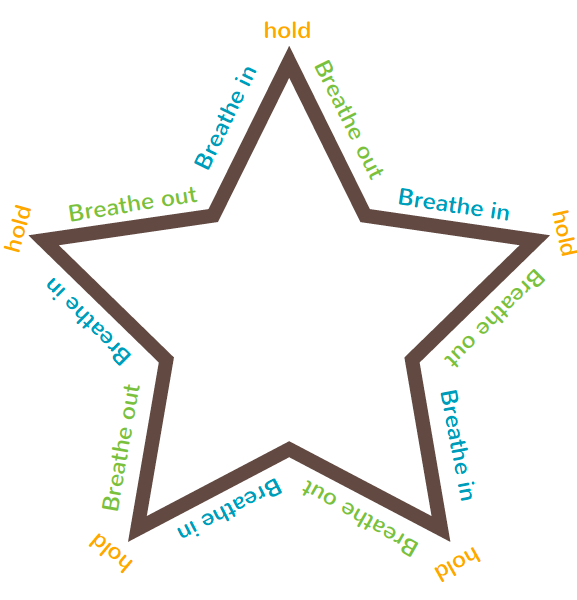
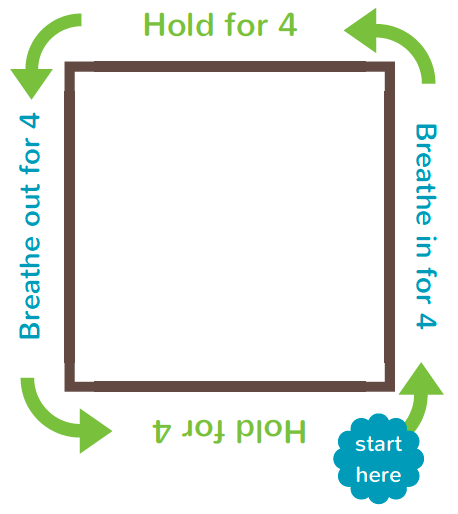
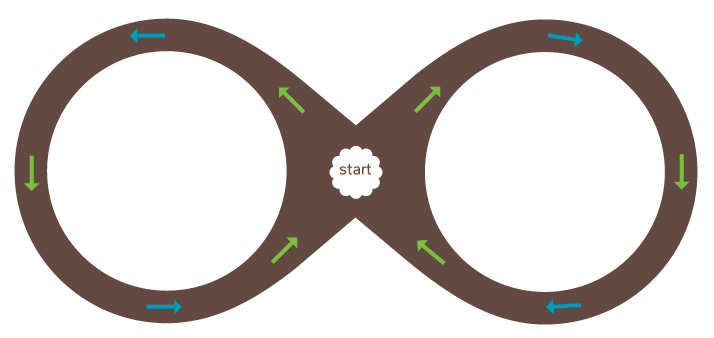
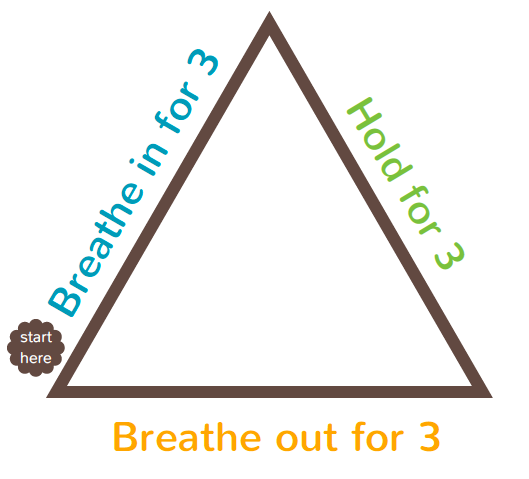
How to do square breathing
So now let’s get down to the how…
Below we have three different guides for you to follow along with.
Right-click on the image and GIF and click ‘save as…’ to have these guides with you all the time.
If you are on mobile simply just hold the image down with your finger and click save to album/gallery and then you will find it on your mobile device’s gallery!
You can also subscribe to our youtube channel if you enjoy this content to follow along with more of our other guides.
Easy peasy!
Before starting:
You can choose to set an intention or invite a neutral or positive image to focus on during your breathing practice.
You can imagine your breath and the pauses/holds in between the breath moving around the image of the square if it works for you. An image of a clock face could also work. Inhale at 12 o’clock, hold at 3 o’clock, exhale at 6 o’clock and hold at 9’o clock.
Option1: Downloadable image graphic
(right-click and press ‘save as…’ on the image or hold your finger down on the image to save it on your mobile device’s gallery)

Option 2: Youtube video-guided
Follow along with my voice in this guided box breathing meditation!
Like and subscribe to our channel for more
Box breathing vs Circle breathing
So we have established that box breathing or square breathing is a common term used for this type of breathing technique where we inhale, exhale and pause in between for the same amount of counts.
But something is lacking in the name of this technique… flow.
Breathing is all about flow – it is a continuous cycle. The ebb and flow as the inhale simply becomes the exhale completely naturally. A rhythm. With no strain or force.
Using the visualization of the box or square in this technique disrupts this flow slightly. It compartmentalizes the inhale, pause, exhale, pause, and doesn’t think of the breath simply just dropping in and out of these 4 stages of breath. The boxiness creates a slight stagnation of breath as you reach the corners and this can bring on slightly more strain or tension as the corners are seen as the endpoint or goal to reach within the set amount of counts. This is especially true when the breath is held.
Perhaps circular breathing or clock breathing would be a better term…
A circle has no beginning or end – it, therefore, leads to a neverending cycle and there is no lul or disruption in movement of breath. Since a circle does not have corners we can access a deeper sense of flow and ease of breath – which makes this exercise quite hypnotic.
Using the visualization of a clock is also a really practical way of knowing when to inhale (12 o’clock), hold (3 o’clock), exhale (6 o’clock), and hold again (9 o’clock), and then repeat this cycle as much as you want or need.
We liked this idea of using a circular breath so much that we created our unique Meditation DNA ‘Circular Breathing’ GIF for an easy way to drop into this breathing practice.
The Meditation DNA circular breathing GIF
(Box Breathing Upgrade)
Save our GIF and have it accessible to you at all times, whenever you need it
Simply follow this link Meditation DNA circular breathing GIF and ‘bookmark‘ the page on your desktop or mobile device
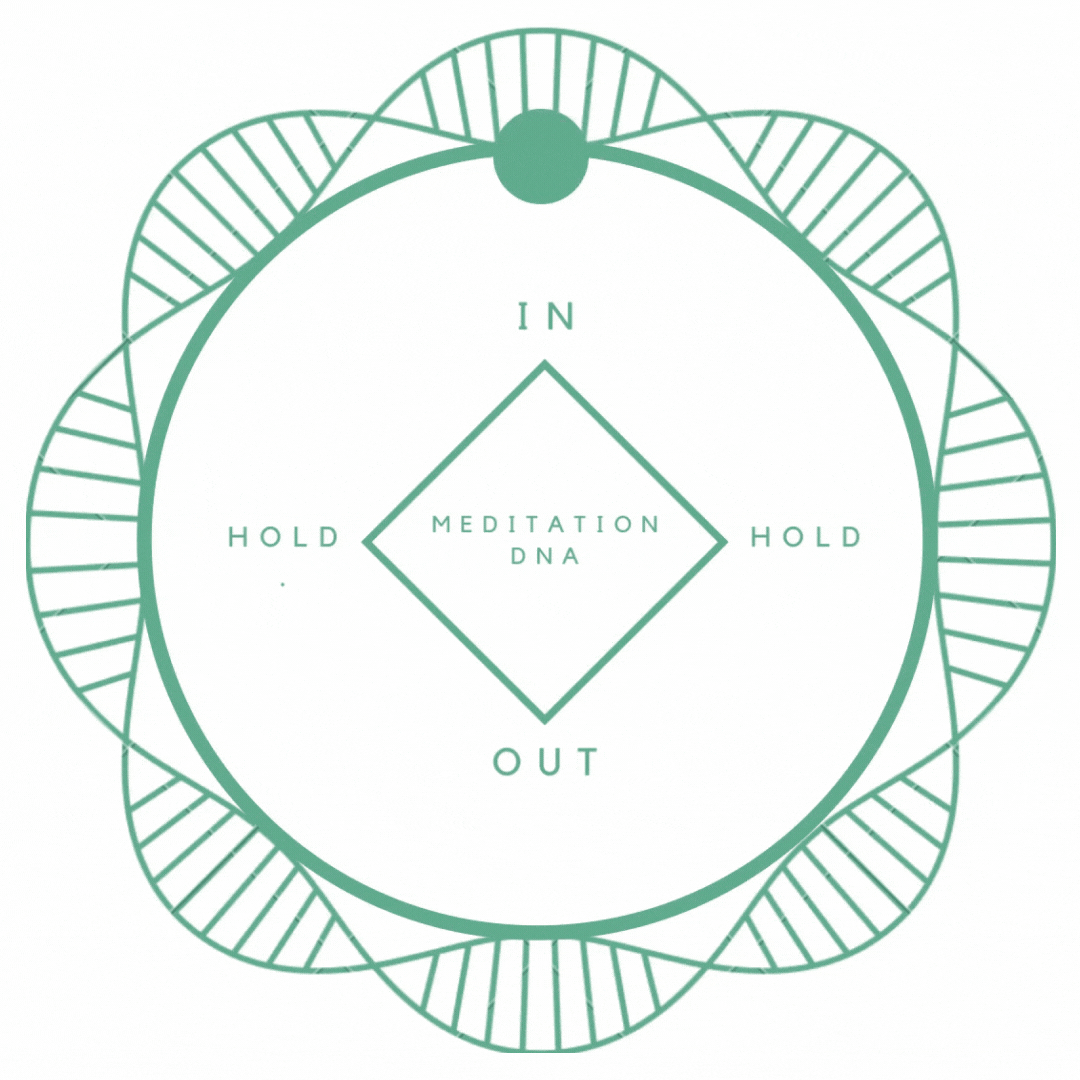
All in all, box breathing/circle breathing is for anyone and everyone that is looking to start a mindful breathwork practice.
I hope you enjoyed this guide about How To Do Square Breathing For Children And Adults. If so please share and spread the word!



